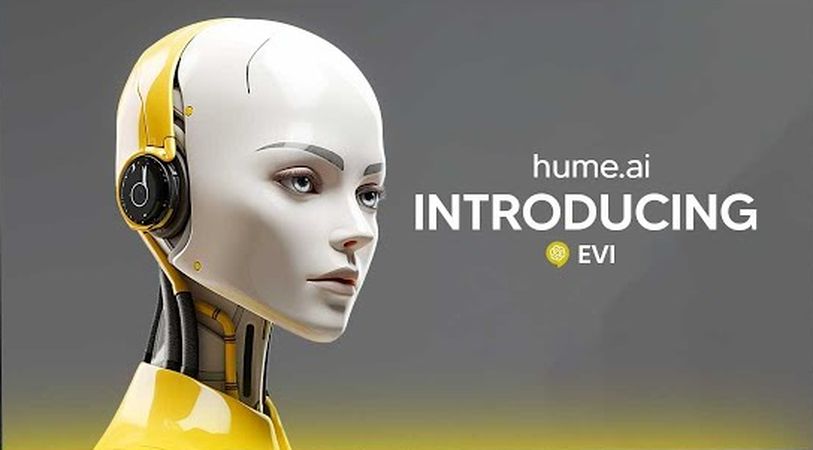Hume AI Review: A Deep Dive Into Emotionally Intelligent AI
Most AI tools focus on language, logic, or automation; Hume AI takes a unique approach by teaching machines to understand and respond to human emotions. Backed by advanced cognitive science and real-world research, Hume AI promises to bridge the emotional gap between humans and machines. But how well does it work in practice? Is it truly a game-changer for developers, companies, and emotional UX design? In this review, we explore everything you need to know about Hume AI: what it does, how it works, who it's for, and how it compares to traditional and alternative tools in the market.
Part 1. What is Hume AI: The Technology Behind the Emotion

Hume AI is a research-driven technology company founded by psychologist Dr. Alan Cowen. Its core mission is to create AI that can perceive and express emotions just as humans do - across speech, facial expression, and text. Unlike traditional voice recognition systems that merely convert speech into text, Hume AI listens for how something is said, not just what is said.
At the heart of Hume AI is its semantic space of emotion, which maps over 24 nuanced emotional states (like amusement, awe, frustration, or gratitude) to various vocal, facial, and linguistic cues. This approach is designed to capture the complexity of human emotion across cultures and contexts.
The system's unique capability lies in integrating multi-modal data-audio tone, visual expression, and verbal meaning-to identify the emotional content in communication. This makes Hume AI particularly powerful in applications that require empathy, such as digital therapy, healthcare, education, and customer support.
Part 2. Hume AI Key Features: What Makes It Unique
Hume AI offers several standout tools that bring emotional awareness into the AI ecosystem. These include:
1. Emotion Recognition Across Modalities
Hume's models capture vocal tone, facial expressions, text, and gestures to detect 24+ nuanced emotions-like amusement, desire, confusion-with high precision.
Their semantic-space theory, led by psychologist Dr. Alan Cowen, uses rich datasets to map emotional expressions in a continuous multidimensional space.
2. Empathic Voice Interface (EVI)
The Empathic Voice Interface is Hume's flagship offering. It's a real-time voice analysis and response engine that evaluates a speaker's emotional tone and adjusts its own responses accordingly. For example, if it detects stress or confusion, it might slow down and use a calming tone to respond.
What's remarkable about EVI is its ability to adapt in real-time conversations. It includes features like:
- Interruptibility detection
- End-of-turn prediction
- Tone-adaptive TTS (Text-to-Speech)
3. Octave - Expressive Text-to-Speech
Octave is Hume's answer to emotion-rich TTS. Rather than flat, robotic voices, Octave lets users specify how they want something to sound-angry, empathetic, fearful, sarcastic, etc. It uses an LLM-powered engine that interprets both emotional tags and natural prompts like "say this gently" or "sound confident".
4. Expression Measurement API
This API allows developers to analyze emotional cues from voice or text input. It returns a set of emotional metrics based on Hume's 24-dimensional emotional model. It's ideal for embedding into applications that benefit from emotional analytic - like customer service platforms, coaching tools, or even smart assistants.
Part 3. User Experience: Who is Using Hume AI?
Ideal Users and Potential Applications
- Developers & Startups: Building emotionally intelligent applications.
- Healthcare & Therapy Providers: Enhancing patient interaction with voice-based emotional diagnostics.
- Customer Support Teams: Understanding caller frustration or satisfaction in real time.
- Academic Researchers: Studying human emotion in communication.
User Experience Insights
Hume AI delivers impressive accuracy and adaptability. In most cases, it detects emotional shifts in tone and rhythm better than standard sentiment analysis models. EVI in particular shines in real-time dialogue.
However, since it's currently cloud-based, it relies on internet connectivity and cannot be operated offline. Its web interface and documentation are sleek and easy to navigate, although full integration into apps may require intermediate coding knowledge.
In short: It's intuitive for tech teams but may be complex for casual users without API integration needs.
Hume AI Price
Hume AI offers a tiered pricing model designed to accommodate different user needs:
- Free Tier: Includes limited API calls and access to demo tools, ideal for evaluation and small-scale personal projects.
- Starter Plan: Priced affordably for small teams and startups, it provides increased API usage limits and basic support.
- Professional Plan: Tailored for businesses requiring extensive API integration, real-time emotion analysis, and priority support. Pricing is typically subscription-based and may require contacting Hume for custom quotes.
- Enterprise Plan: Offers full access to all APIs, advanced customization, SLAs, and dedicated account management.
Note: Specific pricing details are not fully public and may vary based on usage volume and licensing agreements. Prospective users should reach out directly to Hume AI's sales team for detailed quotes.
Overall, while the free tier supports experimentation, scaling commercial applications will involve moderate to higher investment, especially for large volumes or premium features.
Part 4. Benefits and Drawbacks of Hume AI
Pros
- Multimodal Emotion Detection: Voice, text, and visual input supported.
- Highly Accurate: Models trained on large, diverse emotional datasets.
- Powerful Real-Time Capabilities: Ideal for voice-based applications.
- Flexible Integration: Multiple APIs and SDKs for developers.
- Ethical Commitment: The Hume Initiative promotes transparency and emotional primacy.
Cons
- No Desktop or Offline Version: Entirely cloud-dependent.
- Steep Learning Curve for Non-Developers: APIs require technical integration.
- Costly at Scale: Enterprise solutions may involve licensing or subscription fees.
- Limited Multilingual Coverage: Optimal performance in English; other languages still developing.
Bonus. Best Desktop Alternative - Why Choose HitPaw VoicePea
While Hume AI excels as a cloud-based solution for enterprise-grade emotion-aware AI, it falls short for users who prefer local, desktop-based voice tools - especially those working in creative or content production environments.
HitPaw VoicePea is a powerful desktop application designed for voice transformation and expressive audio creation. Unlike Hume, which operates in the cloud and targets API users, VoicePea is tailored for content creators, streamers, video editors, and educators who want an all-in-one AI voice changer and meme soundboard.

Why It Stands Out as a Hume Alternative
- Offline Use: No internet needed; full local processing ensures privacy.
- One-Click Emotion Effects: Change your voice to "angry," "sad," "happy," etc., with simple controls.
- Intuitive Interface: No coding required-just drag and drop your audio files.
- Custom Voice Presets: Useful for character creation in gaming, podcasts, and animation.
- Real-Time Monitoring: Test and tweak emotional effects in real time.
Whether you're producing audio for YouTube or adjusting a voiceover for a course, VoicePea gives you full control-something cloud tools like Hume AI don't offer to everyday users.
Common Questions About Hume AI
Q1. Is Hume AI free to use?
A1. Hume offers demo tools and limited API usage for free, but large-scale or enterprise features are paid.
Q2. Does Hume AI work in multiple languages?
A2. Currently optimized for English. Some features support other languages but with reduced accuracy.
Q3. Can Hume AI detect sarcasm?
A3. Yes. With tools like Octave and EVI, Hume AI can understand and generate tones such as sarcasm or irony.
Q4. Is there a downloadable or desktop version of Hume AI?
A4. No. It's a cloud-based system. If you want offline emotion-based voice editing, try tools like HitPaw VoicePea.
Conclusion
Hume AI represents a significant leap forward in emotionally intelligent technology, pushing boundaries in how machines interpret and respond to human feelings. With products like EVI and Octave, it's setting a new standard for empathy in AI.
However, its web-first, developer-centric design may not be suitable for everyone. If you're looking for a simpler, offline alternative that puts voice expression at your fingertips, HitPaw VoicePea is the tool to explore.
Whether you build AI or just use it to create, understanding emotional context is no longer optional-it's essential. And with the right tools, it's more accessible than ever.










 HitPaw Univd (Video Converter)
HitPaw Univd (Video Converter) HitPaw VikPea (Video Enhancer)
HitPaw VikPea (Video Enhancer) HitPaw FotorPea
HitPaw FotorPea




Share this article:
Select the product rating:
Daniel Walker
Editor-in-Chief
This post was written by Editor Daniel Walker whose passion lies in bridging the gap between cutting-edge technology and everyday creativity. The content he created inspires the audience to embrace digital tools confidently.
View all ArticlesLeave a Comment
Create your review for HitPaw articles